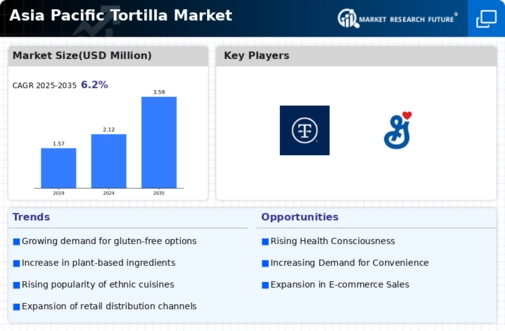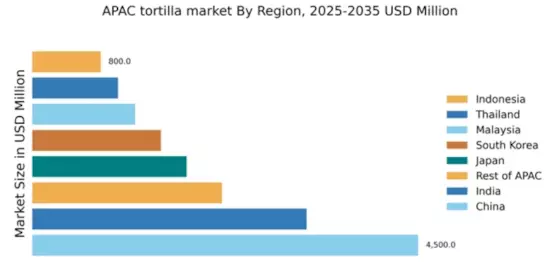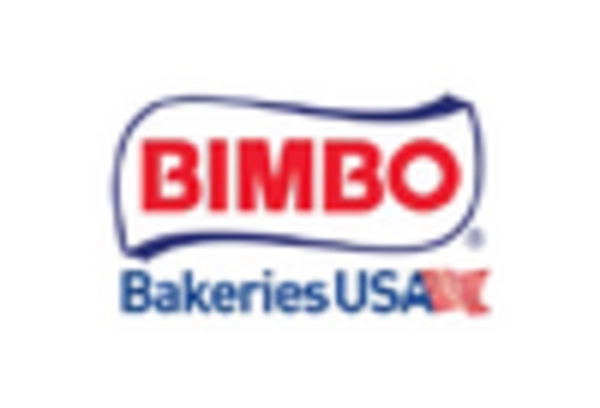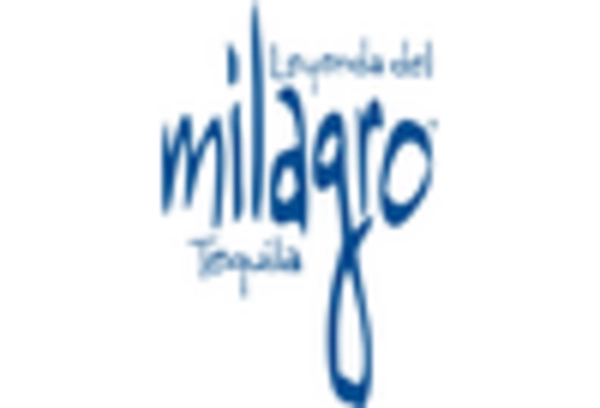China : China's Expanding Culinary Landscape
China holds a commanding market share of 40% in the APAC tortilla market, valued at $4500.0 million. The growth is driven by increasing urbanization, rising disposable incomes, and a growing preference for international cuisines. Demand for tortillas is surging, particularly in metropolitan areas, supported by government initiatives promoting food diversity and safety regulations. Infrastructure improvements in logistics and distribution are also enhancing market accessibility.
India : India's Diverse Culinary Preferences
India's tortilla market is valued at $3200.0 million, accounting for 25% of the APAC market. Key growth drivers include a burgeoning middle class, increasing health consciousness, and the popularity of Mexican cuisine. The government is encouraging food innovation through various initiatives, while urban centers are witnessing a shift towards ready-to-eat products. The market is also influenced by evolving dietary habits and the rise of food delivery services.
Japan : Japan's Unique Tortilla Trends
Japan's tortilla market is valued at $1800.0 million, representing 15% of the APAC share. The growth is fueled by a fascination with fusion cuisine and innovative flavors. Regulatory support for food safety and quality standards is robust, encouraging local production. The demand for gluten-free and organic tortillas is rising, reflecting health trends. The market is characterized by a blend of traditional and modern culinary practices.
South Korea : South Korea's Tortilla Revolution
South Korea's tortilla market is valued at $1500.0 million, capturing 12% of the APAC market. The growth is driven by the popularity of Mexican food and the influence of Western dining trends. Government policies promoting food safety and quality are pivotal. Urban areas like Seoul and Busan are key markets, with a competitive landscape featuring both local and international brands. The rise of food trucks and casual dining is also boosting tortilla consumption.
Malaysia : Malaysia's Diverse Food Culture
Malaysia's tortilla market is valued at $1200.0 million, accounting for 10% of the APAC share. The growth is driven by a multicultural population and increasing interest in international cuisines. Government initiatives to promote food safety and quality standards are significant. Key markets include Kuala Lumpur and Penang, where local and international players compete. The market is characterized by a growing demand for convenience foods and ready-to-eat options.
Thailand : Thailand's Tortilla Market Dynamics
Thailand's tortilla market is valued at $1000.0 million, representing 8% of the APAC market. The growth is driven by the increasing popularity of Mexican cuisine and a vibrant street food culture. Regulatory support for food safety is strong, fostering local production. Bangkok and Chiang Mai are key markets, with a competitive landscape featuring both local and international brands. The rise of food delivery services is also influencing consumption patterns.
Indonesia : Indonesia's Evolving Culinary Scene
Indonesia's tortilla market is valued at $800.0 million, capturing 6% of the APAC share. The growth is driven by urbanization and a rising middle class seeking diverse food options. Government initiatives to enhance food safety and quality are crucial. Key markets include Jakarta and Surabaya, where local and international brands compete. The market is characterized by a growing trend towards convenience foods and ready-to-eat products.
Rest of APAC : Emerging Opportunities in APAC
The Rest of APAC tortilla market is valued at $2213.06 million, accounting for 18% of the overall market. Growth is driven by increasing globalization and the popularity of international cuisines. Regulatory frameworks vary, but many countries are enhancing food safety standards. Key markets include Singapore and the Philippines, where local and international players are expanding. The competitive landscape is diverse, with a mix of established brands and new entrants.

















